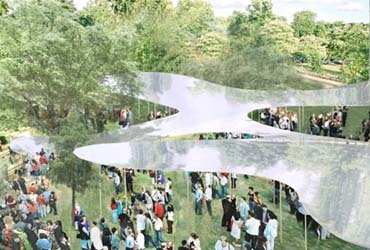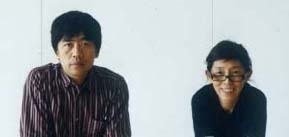Navigating the future
Text: Onishi Wakato
Photo Ikeda Masanori
“The question is how best to navigate the imminent future, in terms of both plans and the qualities of materials.”
When Nishizawa Ryue uttered these words, I felt as though I was hearing the word ‘future’ used in its true sense for the first time in a long while. The 20th century, when we could talk about the future, has ended, and we have yet to discover what the future means in the 21st century. Nishizawa and Sejima Kazuyo of the architectural studio SANAA are without a doubt two of only a handful of talented individuals able to portray what the future might look like.
Take, for example, SANAA’s most important work to date in this country, the 21st Century Museum of Contemporary Art, Kanazawa (2004). The building consists of a thin, discoid cylinder into which have been inserted several cuboid boxes. Each of these structures (or gallery spaces) is as simple as a piece of minimalist art, yet the interior, within which people are able to move around freely, has the appearance of a city. Not just any city, but a futuristic city. To put it boldly, what set their architecture apart are the finely honed abstractness of the form and the texture of the materials, and the almost transparent fluidity of the space.
 Rendering of design for the 2009 Serpentine Gallery pavillion
Rendering of design for the 2009 Serpentine Gallery pavillionCourtesy SANNA
In July this year, a new piece of architecture by the duo is due to be completed in London’s Hyde Park. The Serpentine Gallery Pavilion appears every year for the summer only. SANAA is the ninth studio to be commissioned to design the pavilion, joining a distinguished lineup of previous designers that includes the likes of Zaha Hadid, Ito Toyo, Rem Koolhaas, and Frank Gehry.
The massive, amoeba-shaped roof, which describes a curved surface like a veil, floats above the park. Such was the description in the proposal submitted to the gallery. “We want to create a space that’s integrated with the park and trees as much as possible,” says Sejima. “So the roof will appear to drift freely among the trees.”
The duo chose thin aluminum as the material for the roof, and acrylic sheeting for the wall-like structures that will provide shelter from the wind. “Neither were fully understood as architectural materials in the 20th century,” explains Nishizawa. “This is what makes them so attractive.” The whiteness, lightness, and soft reflection of aluminum. Everything about its texture is appealing, he adds.
SANAA was established in 1995 by Sejima and Nishizawa, who was a member of Sejima’s studio, mainly for the purpose of entering design competitions overseas. Both maintain their own studios, collaborating when suitable projects arise.
The two look just like big sister and kid brother. The kid brother always talks logically. The big sister, on the other hand, uses lots of demonstratives. “There’ll be a big tree here, because we want people to flow like this,” she says, gesticulating. Her words always connote corporeality.
Perhaps this corporeality is something common to the duo, or rather, to the SANAA studio as a whole. Which explains why they carry out study after study and discuss things all together using lots of models. And why the kid brother looks up to the big sister as a ‘mentor’.
SANAA completed the New Museum of Contemporary Art in New York in 2007, and are currently working on a satellite of the Louvre Museum in Lens, France. There’s little doubt that the ‘future’ the duo describes is exactly the kind of thing aspired to by art and art museums that seek to show the way forward.

SANAA (Sejima and Nishizawa and Associates)
Sejima Kazuyo Born 1956 in Ibaraki. MA from Japan Women’s University in 1981. Established Sejima Kazuyo and Associates in 1987. Professor at Keio University. In charge of architectural planning for the Naoshima Fukutake Art Museum Foundation’s Inujima Art Project (scheduled completion 2010).
Nishizawa Ryue Born 1966 in Tokyo. MArch from Yokohama National University in 1990. Established Office of Nishizawa Ryue in 1997. Associate professor at Yokohama National University. Designing a museum to display Naito Rei’s work for the Fukutake Foundation’s Teshima Art Project (scheduled to open in 2010).
Sherman Contemporary Art Foundation (Sydney) presents an architectural intervention by SANAA 7.2-10.22 and their drawings and models will feature in the group show Before Architecture, After Architecture at Tomio Koyama Gallery (Tokyo) from 1-29 August.
Onishi Wakato is a journalist for the Asahi Shimbun.
